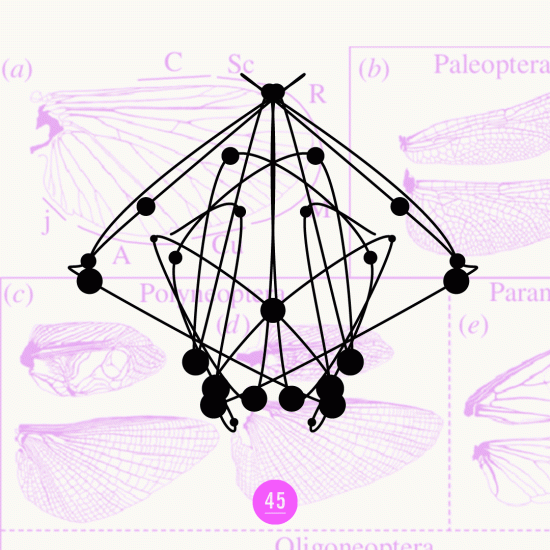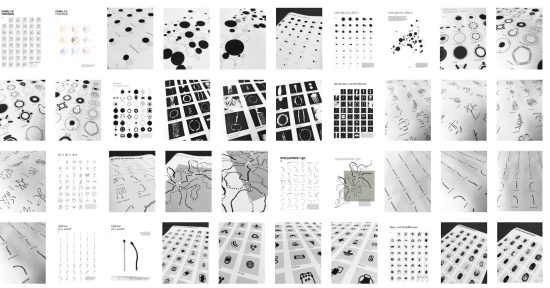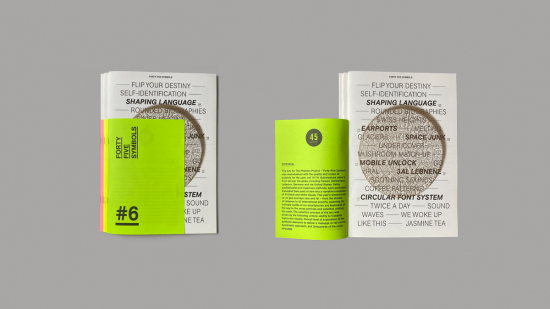The jury for The Phaistos Project — Forty-five Symbols, was overwhelmed with both the quality and scope of projects received during the 2020 open call. Submissions came in from all over the globe, including Japan, Switzerland, South Africa, the United Arab Emirates and the United States.
Because of the long shadow of the COVID-19 virus, projects this year inevitably echoed vast changes in social interaction, the role of scientific machinery, the changed meaning of everyday objects, and even the way we view our own bodies. Artists often utilized transdisciplinary methodology to re-interpret the Phaistos Disc, bringing biochemistry, human anatomy, microscopy, and computer science into the realm of discourse. Each participant composed 45 black-and-white visuals, works ranging from both menacing to playful, in order to imagine compelling narratives about modern life. This year’s winners worked around time, body, and technology to create a diverse portfolio of this essentially transitional period in history.
The selection process of the jury was driven by the following criteria: Ability to translate topics into visuals; Overall level of exploration of the symbolic elements to deliver a message or tell a story; Systematic approach; and Uniqueness of the visual language.
Members of the Jury, Open Call 2020:
Randa Abdel Baki
Associate Professor, Lebanese American University, Beirut, Lebanon
Olivier Arcioli
Lecturer, University of Cologne, Germany
Annelie Franke
Associate Professor, Universidad de los Andes, Bogotá, Colombia
Pascal Glissmann
Associate Professor, Parsons School of Design, New York City
Andreas Henrich
Professor Emeritus, Academy of Media Arts Cologne, Germany
Mariko Takagi
Associate Professor at Doshisha Women’s College of Liberal Arts, Department of Information and Media, Kyoto, Japan
Winning Projects 2020
Ali Razzak —Screen Scrying
Jury Statement
The “SCREEN SCRYING” project plays with a surprising combination of complex scientific analysis with largely artistic visualization methods. The overall effect is an emotionally charged constellation of images which ask questions of both rational and irrational methods of analysis. This look at modern aesthetics of chaos and order take place in the highly charged context of the global threat posed by a dangerous pathogen that brings with it individual and societal upheavals—up to and including existential risk.
Ali Razzak, as a studied bioinformatics scientist, has not only mastered the vocabulary and the methods of the scientific analysis of dangerous pathogens, but also deals with the effect and meaningfulness of these methods as well as their visual forms. He demonstrates an understanding of pathogen representation and, above all, their effects in a social and historical context. In a quasi-Dadaist repositioning of the genetic codes of pathogens, by using several precisely defined steps and assigning meaning to randomly found letter sequences, his artwork generates the effect of looking into a crystal ball.
These 45 symbols are not intended to scientifically represent or otherwise accurately depict the structure of pathogens, but rather they reflect the current methods and tools available to us as a society to somehow imagine or divine the future during such an uncertain time. Above all, they reflect our fears and hysteria towards the invisible and omnipresent threat. The multi-layered and in-depth complexity of this concept, the contrast of logic and fantasy combined with the high visual quality of the 45 images impressively illustrate what Albert Camus, philosopher of the absurd, called the “clash of the irrational with the violent desire for clarity that is loud in the deepest inner human being”.
Chisaki Yuki — Frozen Lives
Jury Statement
In the 18th and 19th centuries, scientists shared their discoveries in “scientific atlases”—carefully crafted publications of newfound knowledge—which included figures and records of research. The term “atlas” was derived from geography, but newly interpreted as a collection of maps that would provide new insights into the human body, the blood cells of birds, and the clouds in the sky, to name a few. Visually, many of these discoveries were framed by instruments: the scientific observations through microscopes and telescopes created circular photographs that were both mysterious and fascinating for laymen.
Chisaki Yuki’s project “Frozen Lives”, recalls these scientific investigations in both process and visual form. Yet, Chisaki is not archiving new facts about the physical world. She is using mundane, everyday objects to take us on a journey that explores our hidden desires and dreams, creating an experience that is not dissimilar to that of interpreting a Rorschach test. Simultaneously, Chisaki transforms the otherwise ordinary act of freezing water to cool our drinks into a reflection on the very nature of time. It is a play on “still life” paintings and artwork and also a nod to the 2020 pandemic, where many people felt their lives were put on hold or “frozen” until the pandemic ends.
Farida Foda — GLITCHED
Jury Statement
Inside clocks, computers and cars, gears and circuits that lie within engender a perfect exterior. As the saying goes, beauty comes from within. To relate this phrase to digital objects, one could say that the inner beauty lies in the respective code. Computers, artificial intelligence, and digital worlds are often created and thought to be man-made models of perfection and beauty. Yet, at the same time, these artificial worlds are cold and distant. Humankind is suspicious of total perfection. Mistakes, errors, and mutations are proof of life itself, our humanity, and our diversity.
What might it look like to manipulate clean image code, delete lines in the genomes and thus destroy pixelated perfection? Would we perceive the outcome as beautiful, or ugly? If our mistakes make us more human, can we find mortal beauty in the faults of our technology?
Farida Foda deals with such digital irregularities in her project, GLITCHED. Her 45 visuals come from a modified and increasingly corrupted image, showing the potential and versatility of minimal irregularities in code as a design tool. In the age of digital transformation, where it seems like image imperfection may become extinct, the artist questions the associated devaluation of our own flawed human imperfections. With only small changes in the genome, innumerable possibilities and interpretations of a single image arise and turn seemingly unaesthetic irregularities into fluid beauty, an imperfect perfection.
Ayaha Kato — In Your Hands
Jury Statement
One of the most essential and effective tools are our hands, yet we take it for granted that they support each of our single actions throughout the day. As long as they function well, we do not pay too much attention to them.
Ayaha Kato observed her multitasking hands and documented single actions and gestures during the day. Instead of rendering her image set in the style of life drawing, she turned them into simplified, strong geometric shapes.
By choosing this style, the hands do not reveal any hint about whether they belong to a man or a woman, a child or an adult, a gardener or a swimmer.
Still, the 45 images that compose “In Your Hands” are not arbitrary. The shapes are reminiscent of paper cutting and kamon, Japanese family crests. Personality, culture, and humanity are present within each of these forms. As a reflective contemporary testimony, the project speaks to the changed significance of hands in 2020. We reflect on a not-so-distant time when we still shook hands and touched without any hesitation.



